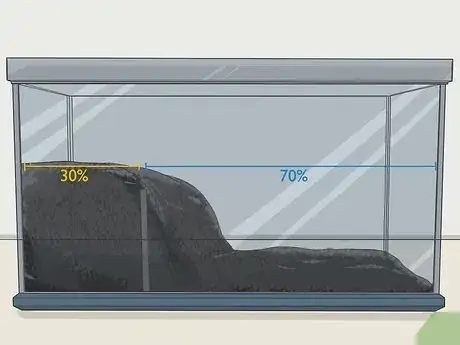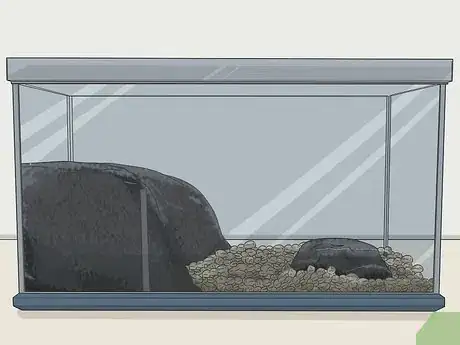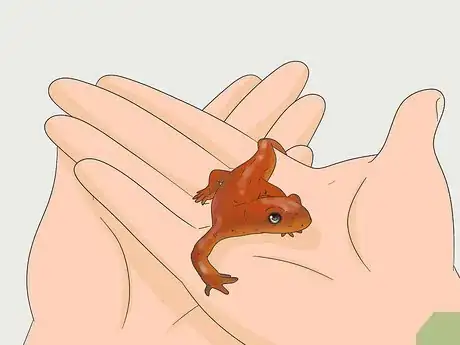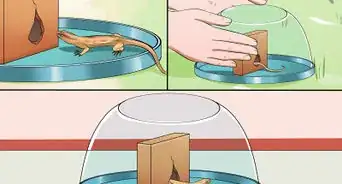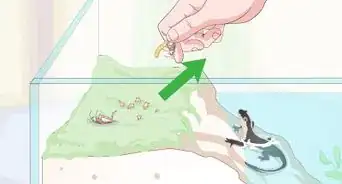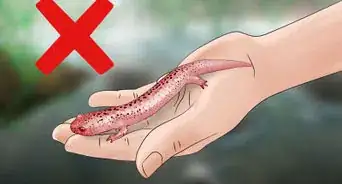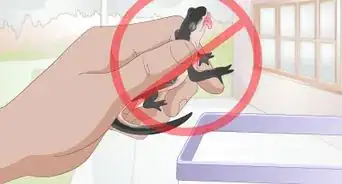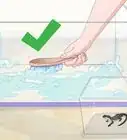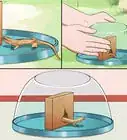This article was co-authored by Pippa Elliott, MRCVS. Dr. Elliott, BVMS, MRCVS is a veterinarian with over 30 years of experience in veterinary surgery and companion animal practice. She graduated from the University of Glasgow in 1987 with a degree in veterinary medicine and surgery. She has worked at the same animal clinic in her hometown for over 20 years.
This article has been viewed 91,777 times.
Fire belly newts are one of the best amphibian pets for any beginner. They’re neat looking, cute, readily available, and affordable. They truly are a great pet for any beginner to the aquarium world. However, newts also present a challenge to pet owners. They live a long time. They can live from 5 to 10 years on average, and up to 30 years if you care for them properly. As an animal with such a long lifespan can truly be a life-long companion, you should do everything in your power to make sure your newt friend has a safe and healthy environment to live in.
Steps
Creating a Proper Environment
-
1Purchase an aquarium. Your aquarium will house the environment that your newt will live in. There are several things you should consider when getting an aquarium, including the size and the number of newts you will house.
- Don’t use anything smaller than a 10-gallon aquarium.
- It is highly recommended that you house 2 newts together.
- You can safely house 4 newts together in a 20-gallon aquarium.
- The larger your aquarium, the happier your newts will be.
-
2Create a proper water/land split in your tank. Fire-bellied newts are semi-aquatic and require both land and water in their habitat. Make sure that you create a proper environment that includes both in order for your newt(s) to thrive.
- The area in your tank should consist of 70% water and 30% land.
- One option is to divide up your tank and build your habitat by creating a partition so that 70% of the surface is water and 30% is land. If you have a partition, make sure you have a ramp so your newts can climb onto the land.
- Another option is to slope your land (gravel or other matter) into the water so that the newts can climb onto the land via the slope.
- Another option is to have 100% water but make sure that 30% of the surface is covered by floating islands and other structures that your newts can rest on.[1]
Advertisement -
3Line the bottom of your aquarium with large gravel. Gravel is a great material to line the bottom of your aquarium. Round gravel will help simulate round rocks found in rivers and creeks in the newt’s native environment. But there are also other reasons to use gravel:
- It will keep your sediment down and help promote clarity in your water.
- Large gravel will be too big for your newt to accidentally eat.
- When wet, gravel is slick and your newt won’t be able to cut or injure itself on it.
-
4Prepare a burrowing substrate, if you want. Burrowing substrate is ground material that will enable your newt to burrow within the land just as they would do in the wild. Allowing your newt to live like it would in the wild is extremely important in maintaining your newt’s health and happiness. Consider:
- Putting your substrate atop large gravel if you are dividing your tank or if you are creating a slope for the newt to crawl from the water to the land portion
- Common materials might include peat moss, sphagnum moss, coco husk, orchid bark chips and more. Consult your local pet stores for ideas or for a pre-mixed bag of substrate.
- Do not use regular soil.
- Make sure any material you do use does not include any chemical additives or fertilizers.[2]
-
5Ensure that you have enough water. Since newts are semi-aquatic, the water portion of your aquarium will be where they spend a lot of their time. You need to make sure that you have enough water for your newts to make sure they stay healthy and fit.
- Your water should be at least 10 inches deep (35 centimeters)
- Water should be at least 70% of the surface area of your tank.
- Your newt should have plenty of room to move around under the water.[3]
-
6Fill your aquarium with plants. Your newts need a nice environment that simulates the environment they’d have in the wild. To do this, you need to populate your aquarium with plants. Consider:
- Terrestrial plants like ferns, mosses, and bamboo.
- Aquatic plants like Egeria and Amazon Sword.
- Other plants native to the newt’s native environment.
- You can also use fake plants as a substitute for real plants.[4]
-
7Recruit your newts. There are two types of common fire-bellied newts, the Japanese newt, and the Chinese newt. The newts are very similar but differ somewhat.
- Pick one species of newt. Try not to mix and match.
- The Japanese newt is somewhat larger (3.5 inches to 5 inches in length at maturity), whereas the Chinese newt is a little smaller (3 inches to 4 inches at maturity).
- The Japanese newt has a speckled red-orange pattern on its belly, whereas the Chinese newt’s belly is more of an orange color.
- The Japanese newt has a rough or bumpy texture to its skin, whereas the Chinese newt has a smooth texture to its skin.
- The Chinese newt’s tail is round at the end.[5]
Caring For Your Newt
-
1Learn about your newt. Fire Belly newts are really cool animals, but you should get to know a little bit about them before you make a big commitment. The good thing about them is that they’re relatively easy to take care of, as long as you maintain their environment regularly and follow simple directions. Make sure to consider that:
- Newts can live up to 30 years.
- The typical newt will live up to 10 years. Be prepared for a commitment. You shouldn’t flush your newt or release him in your backyard when you’re done with him. He’ll probably die.
- The most common fire belly newts are the Japanese or Chinese varieties. The Chinese newt is much more commonly found in pet stores.[6]
-
2Handle your newt with caution. There are a number of reasons you need to handle your newt with caution. Improperly handling your newt could harm the newt or potentially cause you problems yourself. Consider:
- Newts are relatively fragile, if you handle them improperly, you could hurt them.
- Newts have poison glands on the side of their head. If you get some of this poison on your hands, it is likely to irritate your skin.
- Make sure to wash your hands thoroughly before and after handling your newt. You don’t want to contaminate the newt with chemicals or yourself with the poison from its poison glands. [7]
-
3Monitor your water quality. Clean water is essential for your newts’ health and a prolonged life. As a result, changing your water and monitoring your water is perhaps the most time-consuming aspect of owning your newt. Experts highly recommend that newt owners invest in a water filter to make sure the water quality stays consistently high.
- Only use dechlorinated or spring water. Avoid chlorinated water or water with other chemicals at all costs.
- If you don’t have a filter, you’ll have to change your water every day.
- If you do have a filter, you’ll have to change and/or add a third of water every week.
- If you can’t tend to the water as prescribed, you should consider a different pet. [8]
-
4Clean your habitat. Aside from water cleaning and filtration, you need to clean your aquarium regularly to make sure your newt’s habitat is healthy and functioning. A clean and well-maintained habitat is key to your newt’s health and longevity.
- Clean every two weeks or so.
- Take out your newts and temporarily house them elsewhere while you are cleaning.
- Remove all water, plants, rocks, any anything other than the gravel and substrate.
- Sterilize fake rocks, fake plants, and other plastic aquarium monuments with reptile friendly sterilizing solution. Consult your local pet store for this solution. Make sure to read the directions carefully.
- Refill with clean water and replace everything you’ve taken out.
-
5Maintain a proper temperature in your newt’s aquarium. Newts need to have a specific set of environmental factors to thrive, the most important being temperature (next to having a moist environment). You need to maintain a relatively stable temperature range for your newt to thrive as it would in the wild. Consider:
- The temperature in your aquarium should be no higher than 68 °F (20 °C). Avoid temps cooler than the low-50s. Monitor this often.
- Higher temperatures will stress your newt and cause discomfort or death.
- Keep your aquarium out of direct sunlight and consider storing it in the basement where it’s usually cooler.[9]
-
6Feed your newt properly. You’ll have to feed your newt a proper diet. You can give your newt either live or frozen food. Newts don’t have to eat every day, either. You can feed them every other day. There are a number of readily available food sources:
- Earthworms.
- Bloodworms.
- Crickets.
- Chop your newt’s food up to make it easier on them.[10]
-
7Avoid housing your newts with other animals. You might be tempted to cohabitate your newts with other animals. However, before you do this, you need to check with your local pet store. Because your newts secrete a poison, they might harm other animals or poison the water for fish. At the same time, larger reptiles or fish might kill or injure your newt.[11]
Warnings
- Keep newts at room temp. (62-74 degrees Fahrenheit) as they will die if you put them under any type of heat lamp. They actually like their water cool to the touch.⧼thumbs_response⧽
- Always wash your hands before and after handling newts.⧼thumbs_response⧽
- Don't handle newts unless you're cleaning their tank! They're really cute but it can hurt them or you when you handle them more than you have to.⧼thumbs_response⧽
References
- ↑ http://www.theamphibian.co.uk/fire-bellied_newt_caresheet.htm
- ↑ http://nicolesreptiles.weebly.com/fire-belly-newt.html
- ↑ http://www.theamphibian.co.uk/fire-bellied_newt_caresheet.htm
- ↑ http://www.reptilesmagazine.com/Care-Sheets/Japanese-Fire-Bellied-Newt-Care-Sheet/
- ↑ https://firebelliedtoad.wordpress.com/2008/01/29/fun-facts-about-fire-bellied-newts/
- ↑ http://www.caudata.org/cc/articles/firebelly.shtml
- ↑ https://firebelliedtoad.wordpress.com/2008/01/29/fun-facts-about-fire-bellied-newts/
- ↑ http://www.theamphibian.co.uk/fire-bellied_newt_caresheet.htm
- ↑ http://www.tetra-fish.com/Fauna/reptile-information-center/salamanders-newts-as-pets-faq.aspx
About This Article
To care for fire belly newts, start by preparing a tank that consists of 70 percent water and 30 percent gravel or substrate. Additionally, install a filter to keep the water clean, which is important to keeping newts healthy. Once the newts are in their tank, feed them daily or every other day with chopped up earthworms, bloodworms, or crickets. You should also clean the tank every two weeks, making sure to remove the newts first so you can take out and sterilize everything inside. For advice from our Veterinary co-author on how to choose between Japanese and Chinese fire belly newts, read on!

